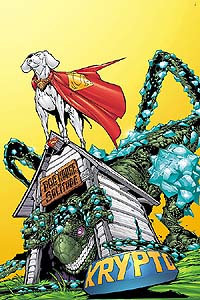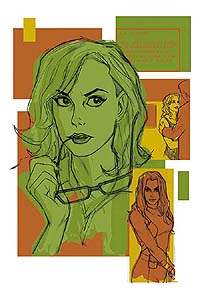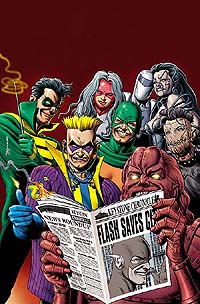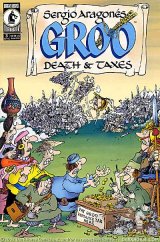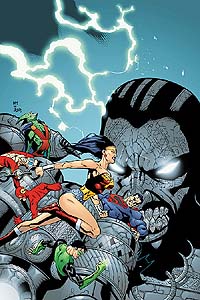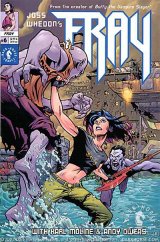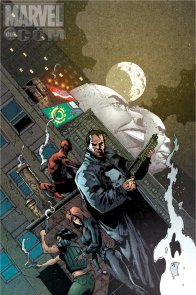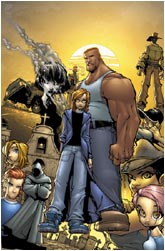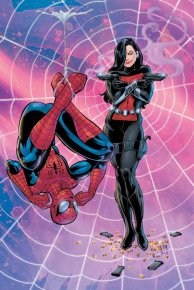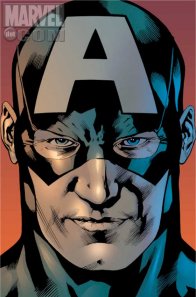|
Each week we take a critical look at some of the best books on the stands, courtesy of Big Guy's Comics (the unofficial comic book store of FanboyPlanet.com). If you publish a book that you want us to be covering, contact us. Or contact Derek. He doesn't have enough to do.
Hey Kids! Comics!
(special note: yes, I suck. The past two weeks I simply got too busy to review comics, but I'm back on track. Please, come back. I won't let it happen again. Herein, too, are last week's reviews from Charlie Wentling, who unfortunately won't be able to review CrossGen books this week. Is it too glib to say you should probably buy them anyway?)
Action Comics #789
Man & Beast
writer: Joe Kelly, artists: Duncan Rouleau and Marlo AlquizaIf I were a kid looking for a cool comic at the local drugstore, the cover of this issue would completely suck me in. But of course, there are no kids looking for comics (are there even local drugstores anymore?) and Action Comics #789 is indicative of the problem.
Despite a whimsical cover that promises thrills and a scary/funny monster story, what lies inside is an almost incomprehensible mess. If you're not a long-time follower of Superman, you would have no idea who the villains are or what their beef is with The Man of Steel. And I'll cop to it: I did not read the book for several months, and am trying desperately to play catch up with everything about Pokolistan, and Kelly is not helping.
Part of it is purposeful. Kelly wants to keep General Zod a mysterious figure. But already a lot of continuity has built up around Zod and his followers, almost none of which gets an explanation here. Superman birthed Kancer from his body? Rather disgusting, and is it true?
All the Superman books suffer from this to some extent, but somehow writers like Mark Schultze and Jeph Loeb have managed to tell straightforward stories and catch new readers up to what's going on. Kelly assumes everybody knows, and worse, devotes too much time to fight scenes that really don't move the story along.
Kancer's strange resemblance to the American Godzilla hurts, too. Exactly how big is he? As big as any given panel needs him to be. It doesn't reflect well on Rouleau and Alquiza's storytelling skills. Nor does the odd resemblance between Kancer, a battered Superman, and this issue's surprising mystery villain. (Sorry, Jeph, they resurrected another one.)
Rumor has it that a big creative shake-up may be coming down the pike for the Superman books. It can't come soon enough. The most accessible hero in comics should not be in a title this inaccessible.
Rating:

Birds of Prey #41
Felony Matters
writer: Chuck Dixon, artists: Rick Leonardi and Jesse DelperdangOkay. Granted, Batman no longer wants to have anything to do with his Bruce Wayne identity. Still, a murder has been committed in his name. So why is he leaving it completely in the hands of Oracle (begrudgingly, at best) to find out who really did it?
At least this book is worth carrying that thread of the plotline. Dixon moves it along at a quick pace. Even though it's part of an ongoing cross-over, the story stands well enough on its own, with each subplot coming to a minor close while leading to more action to come.
Quietly, Barbara Gordon has become the real detective of the group, and Dixon lays out her investigation clearly. With a story like this, it could be easy to just blink over technobabble, but since Barbara has Dinah, she has to keep things on a simpler level. It helps both Black Canary and us.
Leonardi remains a great choice for this book, though the letters page mentions that a bunch of artists will be rotating through in the months ahead. Delperdang still inks just a bit too heavily; maybe on his next assignment someone can tell him this isn't Kirby.
Rating:

Crux #12
writer: Mark Waid, artists: Steve Epting and Rick Magyar
reviewed by Charlie WentlingMark Waid's final issue turns out to be his best one. It's good to go out on a high note.
Capricia has finally learned that the stranger who awakened her group is actually her old friend Danik. They have a conversation that hints at things to come and brings them to an understanding. Though she still doesn't know Danik's motives, Capricia seems willing to give him the benefit of the doubt.
Meanwhile, Tug tries to extract some information from the captured Negation bounty hunter. Even though Tug is a peaceful man, the urgency of the situation leads him to torture. The scary thing is how ineffective that torture is to The Negation. Things take a sudden turn, leading to a stunning and somewhat gruesome ending.
It's too bad that Waid is leaving. He has finally laid out most of the groundwork for the characters and their situation. The Negation have a real sense of danger and gravity about them. Hopefully this will continue in Chuck Dixon's hands.
Rating:

Elektra #8
writer: Greg Rucka, artist: Chuck AustenChuck Austen has really grown over the course of this series. Each month, the characters look less and less like they could guest on King of the Hill. His fight scenes strike just the right balance between exciting and awkward, making them some of the most realistic (as opposed to just bloody) violence in comics.
He also has a good way with emotion, though tending to rely almost too heavily on shadow to achieve it. Still, it comes in handy as Elektra tracks down the four men who allegedly raped her client. Of the four, two clearly would again, but one does seem to have repented, and Austen carries that through in the power of his drawing.
There's also an uneasy element of irony as one of the four is a software magnate, creating rendering engines seemingly just so videogame women can have firmer, bigger breasts. While Austen does not seem quite so obsessed, it's no secret that Marvel promotes Elektra has a hot fantasy woman. One can only wonder what will happen in her own upcoming videogame.
This story seems quieter than Bendis' arc, but Rucka has made it no less intriguing. Actually, without the real-world politics blending with the Marvel Universe, this one may even be easier to follow. Already a pattern is developing, though, in that we're splitting focus once again with an unwilling single male agent. While Chris Olson probably won't turn out to be an LMD, it might have made more sense to leave men out of this gynocentric tale.
After all, if any sister can do it for herself, it's Elektra.
Rating:

The Flash #184
Run: Program
writer: Geoff Johns, artists: Scott Kolins and Doug HazlewoodAfter a few months of teasing, we finally get the new Rogues' Gallery making its move. And a big one it is, too. Just as Wally starts figuring out that there might be some conspiracy against him, the Mirror Master delivers the coup de grace of kidnapping the entire police force.
Unfortunately for the Rogues, someone they didn't draft into their number also has a plan against Keystone City and its most famous son. Neither they nor we could have seen it coming.
Leave it to Johns to throw a monkey wrench into his own proceedings. Even when he gives us the expected, it comes about with an unexpected twist. And clearly, the big action is yet to come.
For some of this issue, though, Johns has to fudge things a little. This marks the first issue under his writing that seemed like The Flash was incapable of a couple of speed stunts only because a plot point might not work otherwise. It may seem nitpicky, but when The Weather Wizard challenges, "can you outrun lighting, Flash?" isn't the answer, "well, yeah?"
Kolins and Hazlewood probably don't get enough attention for the fine work they do here, though in an interview this morning with Comic Book Resources, Kolins did let slip that DC will start letting him do the covers. As good as Bolland has been, it's better to see this unique art team get a little more upfront coverage.
Rating:

Groo: Death and Taxes #3
writers: Sergio Aragones and Mark Evanier, artist: Sergio Aragones
reviewed by Charlie WentlingGroo has taken an oath to stop killing people, and the surprising thing is that he is sticking to it. This is a four-issue mini-series, so maybe the vow will only last through next month's conclusion. I'm not convinced, though; it could be a permanent change. When Groo finally learned to read back in his Marvel days, the series only got better.
Even without Groo killing people, the story is still exciting and amusing. The Sage guest stars, and even with all of his wisdom he is perplexed by the change in Groo. The surrounding kingdoms are preparing for war. This war is one with no cause; the king sees how the economy does better when there is conflict, so he manufactures an enemy.
Three champions all come in search of Groo to kill him. The barbarian manages to unwittingly outsmart them without even drawing his sword. My favorite parts of the issue are the double-page spreads. Sergio draws enough detail into them to put the Where's Waldo books to shame.
Rating:

Howard The Duck #3
Bad Girls Don't Cry
writer: Steve Gerber, artists: Glenn Fabry and Garry LeachIs it passé yet to mock the bad girl craze? Though such characters are still around (including this issue's direct target), it seems like it's all been done.
When a homeless Howard and Beverly encounter Bev's high school rival and now Cleveland cop Suzi Pazuzu (perhaps you can already pick up who is being parodied), the whole storyline seems to stop so Gerber can make a few stabs at the industry that may be a couple of years too late.
Instead of really forwarding Dr. Bong's plans for the duo, we get character after character ripped from the pages of a Top Cow book (though, in a nice nod to Howard's past, one cop did help the Duck face down the Hellcow many years before). Yes, the best of this title always had great digressions, but this is more and less than that. Gerber just takes obvious shot after obvious shot, mocking what he obviously considers lazy writing with …more lazy writing.
Sure, I sound like a cranky old man. Howard The Duck was better in my day, the first time around. And though this revival still has some laughs, it feels hollow. Worse, juvenile. And that's something that this book never was before in the hands of its creator.
Rating:

JLA #64
Golden Perfect, part 3
writer: Joe Kelly, artists: Doug Mahnke and Tom NguyenIt's hard to believe that this is the same guy who writes Action. With ostensibly more characters here, Kelly manages to subtly recap what has gone before while never slowing down. He has even worked in a pretty heady concept, dealing with the subjectivity of truth.
Luckily for the League, these pockets of mass belief have been only temporary. Therefore not too many people fell to their deaths from the flat earth. Kelly has fun with comic book conceptions, too, though. The Riddler's riddles temporarily become as obtuse as any on the old TV show (too big a leap in logic even for The Riddler himself to solve), and Kyle Rayner transforms into the one, true Green Lantern. Take that, fanboys.
All of it gets carried through by the dynamic work of Mahnke, though Nguyen may not be the best inker for him. Mahnke already has a complicated penciling style, which needs a lighter touch. Nguyen makes this look a bit like Soviet propaganda. Just lighten up a bit, okay? This stuff is still supposed to be fun.
Rating: 4.5

Joss Whedon's Fray #6
writer: Joss Whedon, artists: Karl Moline and Andy OwensIt seems like months since this book last came out. Granted, Dark Horse has been having some financial trouble, but we could wish to get this out a little more regularly.
Melaka finally convinces her fellow downtrodden that the Lurks aren't just twisted mutants, but only after losing her best friend. While her brother gathers the vampire masses, her sister contemplates turning her back on the police force to join in the coming battle that no one else believes. Oh, and for reasons of their own, a cabal of demons does not want to unleash hell on earth. Not yet, anyway.
With typical Whedon style, it comes to a head nicely, and Moline and Owens keep it moving. Though it's still puzzling why vampires have a different coloring in the comics, the artists have managed to stake their claim on some unique demon designs.
Though related to Buffy, this series has carved a nice corner of its own, and taken as a whole (eventually) should attract a lot of fans who don't normally read comics. But is it helping when they're only reading reprint collections?
Rating:

Marvel Knights #1
Enter The Brothers Grace
writer: John Figueroa, artist: Alberto PonticelliThis re-launch promised something different from the previous series bearing its name. But it still deals with a bunch of loner street vigilantes uncomfortably teaming up to fight some menace too complex for any one of them to handle alone. The only real difference seems to be that the "dinosaurs" let go from the book, Chuck Dixon and Eduardo Barreto, knew how to actually write and draw, respectively.
Figueroa seems to be trying a riff on Garth Ennis. The pieces are there, with suitable bits of ultra-violence and villains with the right touch of the grotesque (in theory, anyway). But he doesn't have the sardonic humor, nor the subtle morality, of Ennis. The Brothers Grace are evil, but it's not particularly clever to have them also have made an art film. And though their predilection for plastic surgery could be a good character bit, it's devoid of context or sense. "No one knows what they really look like," Sergeant Helen Kim offers. Duh. They really look like whatever their plastic surgeon has made them look like.
And the writer gets no help from his artist. Ponticelli has a decent sense of layout, but all of his figures and faces are somewhat grotesque. It's hard to be horrified by The Brothers Grace when they never look the same way twice even without plastic surgery; worse, no character ever looks the same way twice.
He's not particularly imaginative, either. Henchman Mr. Tune considers himself an artist in mangling people, considering them living works of art. But as Ponticelli draws it, every victim ends up in the same position.
Almost everything about this book feels like Marvel was giving a couple of kids a chance, but they're not ready for the big time. They both settle for something less in a book that is tricky enough in conception to make work. You have to have a really good reason for Daredevil to work alongside The Punisher, and this just isn't it.
Rating:

Out There
Twisting Roads
writer: Brian Augustyn, artists: Humberto Ramos and Sandra HopeThis is a whole lot bigger than we thought.
While Augustyn moves forward a plotline of cosmological significance, he quietly pauses to remember that small stories of the supernatural can be creepy, too. The survivors of El Dorado have stopped in Sterling City, Arizona. Ostensibly it's to take a break from their troubles, as they sightsee in this wild west town.
But it also turns out that Reverend Becky knows more than she has let on, and that several religious orders have banded together to combat Draedalus and his ilk. (One character who we knew was more than he seemed turns out to be that ilk.)
What makes this issue stand out, though, is Adam, a grieving father literally haunted by his late wife. Unfortunately for Mark, he's a dead ringer for Adam's son Denny, and becomes the target of a supernatural obsession.
Is it related to the overall arc? Maybe, maybe not. It might be cooler if it isn't. Ramos and company lay the groundwork for there being a lot of different powers that be, both good and evil, and it's almost more frightening to think that not everything serves one grand plan.
I'll admit that as much as I have enjoyed this series, I thought it would be pretty much one note throughout. Thankfully, I was wrong.
Rating:

Scion #22
writer: Ron Marz, artists: Karl Moline and John Dell
reviewed by Charlie WentlingKai, Elena and the Heron army are ambushed by the Ravens. The majority of this issue shows the fighting between the two armies. Kai also goes one-on-one with Bron. The combat is well done, and we learn that Bron is just as hard to kill as Ethan was. Mortal wounds can be healed.
This is the first art by Karl Moline that I have seen. He does a solid job in his CrossGen debut; not as good as Jim Cheung, but that may not be a fair comparison. Moline's interpretation of Ashleigh seems off, but the other characters look good.
The issue ends with Ethan's return to the surface world after last month's visit to the undersea city of Haven. He was unsuccessful in Haven, but he has come up with an alternative sanctuary for the lesser races that seems so perfect that it was obviously Ron Marz's plan from the beginning.
Rating:

Spider-Man's Tangled Web #12
I Was A Teenage Frogman
writer: Zeb Wells, artist: Duncan FegredoSuddenly the infamous Beach Fun Spider-Man action figure makes sense. The wallcrawler takes a cab out to the suburbs to check up on the paroled Frogman, and, wishing to go incognito, throws jeans, leather jacket and baseball cap over his costume. Actually, it's kind of stupid, and yet so in character for Peter to do.
But as in the best of this title, his appearance is brief in addition to ridiculous. Instead the story focuses on the hell of high school, specifically for Eugene Colorito, son of the "infamous" Frogman. With his father a paroled and pathetic super-villain, the chubby Eugene suffers as a compound target for bullies.
If memory serves, Eugene spent some time as Frogman himself, trying to be a sidekick to Spider-Man. Wells' take on it here makes more sense, and leaves things open enough that (if you must) you can fit it into continuity.
What sets this apart from previous Frogman appearances is that it really does ring true in its depiction of the embarrassed son/father relationship. And Wells provides one of the best answers to the question: why be a super-villain?
All of it gets beautiful work from Duncan Fegredo, who even does his own coloring. He has a solid, recognizable style that doesn't appear often enough.
Rating:

Ultimate Marvel Team-Up #14
Spider-Man and Black Widow
writer: Brian Michael Bendis, artists: Terry Moore and Walden WongOkay, when the worst thing you can say about a book is that there's a coloring error on the cover (Natasha's hair is black instead of red), you know that something terribly right is going on here.
What's coolest about this book is the glimpse of the wider Ultimate universe that Bendis provides. Dr. Doom has yet to actually appear in any of these titles, but already we know a lot about him. Also unexpectedly, this title has its own continuity, with a seemingly throwaway character from the Iron Man team-up playing a crucial role here.
As for the Black Widow herself, she's younger, a little sexier, and a lot sassier than the Natasha we know. But then, that Natasha is too much a character out of time; no wonder Marvel tends to focus on her successor. This version is just as good at what she does, and will definitely be appearing again.
Bendis also writes the most realistic teen-aged Peter Parker ever. Granted, in Lee and Ditko's time the image of teenagers was much more pristine, even if teens themselves weren't. It's still good to see someone write him as a guy who hasn't quite learned all the lessons he should, driven by morality without being consumed by it.
And as Spider-Man confronts the Black Widow, it's also a nice touch to remember that as a young man, it won't just be Peter's spider-sense that tingles.
Rating:

The Ultimates #3
21st Century Boy
writer: Mark Millar, artists: Bryan Hitch and Andrew CurrieFor whoever whined to Bill Jemas in his column a couple of weeks ago: still no Thor, though once again he gets mentioned. No, though the name of this book is The Ultimates, the real focus is Captain America. And even though much of his story remains familiar, Millar has put a fresh spin on the human side of it all.
In this issue, in fact, no crime gets fought. No battles are waged. Instead, Steve Rogers has to face just what it means to have been on ice for 57 years. His fiancée married Bucky, and the two went on with their lives. The only relatives Rogers has have never met him, and likely have never even heard of him. It's like the Mel Gibson movie Forever Young, only without the butt shot and annoying child subplot.
Captain America must find a reason to go on, and though the answer is obvious, it seems somewhat surprising coming from Millar. If you feared this was going to be a Marvel version of The Authority, don't. At least one character in this book will be fighting for what's right for all the right reasons. And it's not necessarily the president.
Giant-Man and The Wasp appear here, too, and already Millar has thrown in more realistic consequences to their powers than I've ever read in the pages of The Avengers. Once again, Marvel has done it right.
Rating:

For alternate views and more books, check out Daryl Tay's site, Unique Frequencies.

All comics were reviewed by Derek McCaw unless otherwise noted.













